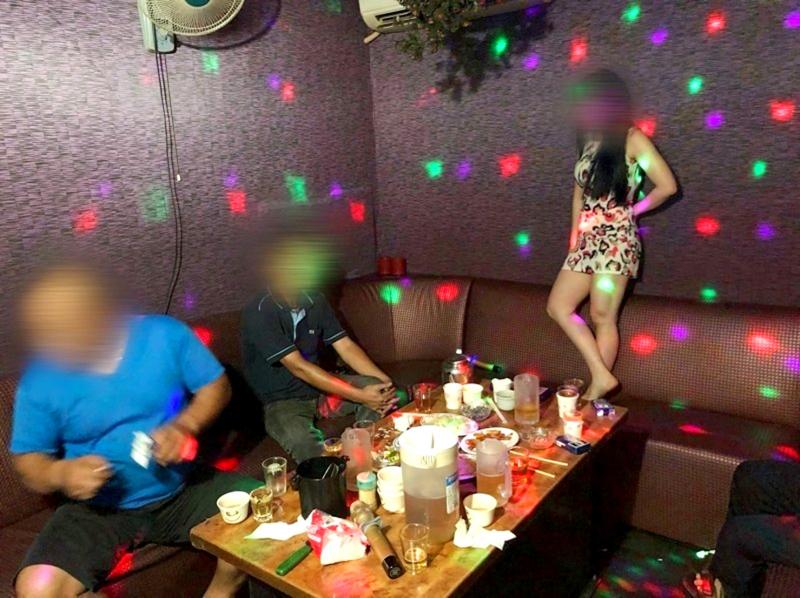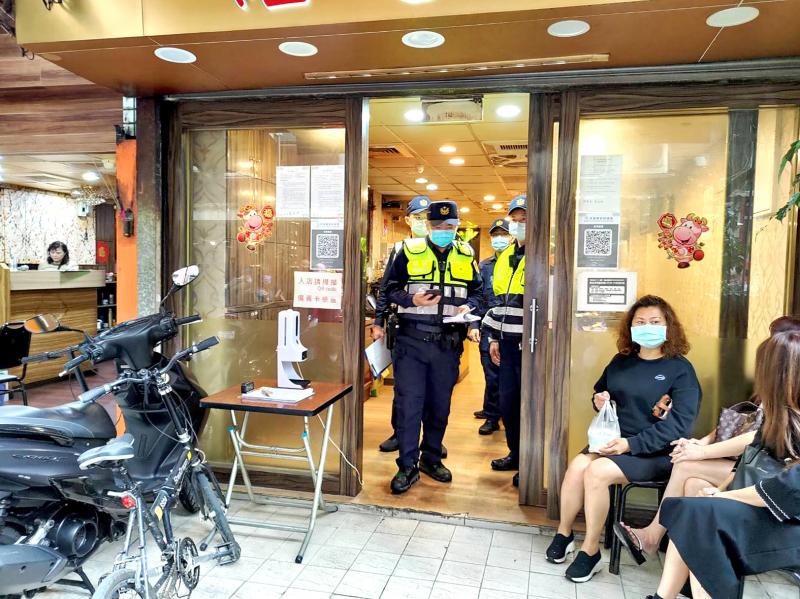Readers may recall that several early COVID-19 outbreaks in Taiwan were linked to the island’s a-gong dian (阿公店), “shops for grandfathers,” a local nickname for hostess bars and teahouses frequented by older men. As cases are currently skyrocketing, and the elderly remain a less vaccinated population, the sex trade could soon be back in the news.
Last year the spike in COVID-19 cases led to calls for crackdowns on areas hosting the sex trade. The Taipei Times reported in May that Control Yuan member Lin Kuo-ming (林國明) had called for a crackdown on the sex trade in Taipei’s Wanhua District (萬華), which hosts over 100 such establishments, claiming that local officials had been negligent.
That month 172 hostess teahouses were closed for disinfection after the Taiwan Centers for Disease Control (CDC) linked 155 COVID-19 cases to the sex trade in Taipei alone.

Photo: Lin Chia-dong, Taipei Times
Recognizing the problems with an unregulated sex trade, other officials argued that Wanhua be turned into a legal red light district. Would that be a good idea?
In 2011, Taiwan legalized local governments establishing red light districts, the result of a ruling of the Grand Justices in 2009 that Article 80 of the Social Order Maintenance Act (社會秩序維護法) was unconstitutional since it punished sex workers, but not their clients.
To date local governments, facing objections from various social groups, have yet to implement a single red light district. A Taipei City Government spokesman said in 2011 that the city would not move on it since “there is no public consensus on this highly controversial issue.” That remains the consensus of the local governments.

Photo courtesy of the Wanhua District Police Department
In 2020 there was a brief proposal by a bipartisan group of legislators in Changhua County to erect such a zone there for health and safety reasons, as well as revenues. It came to nothing.
RED LIGHT DISTRICTS OF THE PAST
It is regrettable that this opportunity to test the idea has been ignored. Yet, red light districts have a long history in Taiwan, which may offer illumination.
Beginning in 1896, to address hygiene and public order issues, the incoming Japanese colonial government established the “kashizashiki designated area” in each city. Prostitutes could only legally ply their trade in that area.
The Japanese initially focused on putting in infrastructure like water and sewage, but after 1900 real city planning began. An interesting paper by Sammonji Masaya observes that after Taiwan became Japanese, numerous Japanese sex workers made the journey to Taiwan. To regulate this trade, the red light districts, informally known as yukaku, were established. Sammonji writes that meant that before city planning and before even government buildings were erected, the formal existence of a city to Japanese eyes was signaled by the existence of a yukaku.
A colony-wide ordnance was promulgated in 1906. It required that prostitutes be licensed and registered, and periodically undergo medical inspection.
Sixteen cities eventually hosted yukaku, according to Sammonji, including Taipei, Keelung, Hualien, Taichung, Tainan, Hsinchu and Kaohsiung. In Tainan, for example, they were located on reclaimed land by the harbor, with different yukaku for Japanese and locals.
In many cities these areas shifted over time. For example, in Miaoli, one district existed from 1897 to 1902, then the second from 1902 to 1924, and the last from 1924 until the end of Japanese rule.
According to scholar Jin Jung-won (蔡孝乾), after 1920 Korean procurers also brought in prostitutes from Korea who worked in chosenros, brothels in Taiwan that specialized in Korean women (no Taiwanese females went to Korea for such purposes), as the number of Japanese prostitutes fell off. By 1940 these women accounted for roughly a quarter of the 1,000 licensed prostitutes in Taiwan (the number of licenses was held at around that figure). Taiwanese women accounted for less than a tenth of this number.
Why were Taiwanese women excluded from this market? The state saw them as carriers of disease and racial decay. Jin observes that because of racial theories arguing that contact with tropical climates and their natives led to racial degeneracy, “securing a safe prostitution market seemed possible only if Taiwanese could be excluded from the market.”
Of course, locals continued to work in the trade as illegal prostitutes, and eventually revenue-starved cities such as Tainan quietly erected yukaku for them.
The yukaku system ended with the Japanese, to be replaced by the mess of legal and illegal prostitution under the Chinese Nationalist Party (KMT). Sadly, because of its deep coloniality, this long history of legal prostitution and red light districts under authoritarian governance appears to have little application to our current problems.
HYPOCRITICAL SYSTEM
Under the Japanese, the structure and “hygiene” function of red light districts was avowedly colonial: their purpose was to protect Japanese males from encounters with women infected with STDs. The male customers themselves were not subjected to testing, only the sex workers.
Similarly, colonial-style prostitution was legal throughout the KMT era, driving trafficking of indigenous women and women from elsewhere in Asia. Males could solicit sex workers without fear of the law, because only the sex workers were breaking the law. Sex work under the party-state also included the sick practice of arresting women for sex work and then giving them the choice of going to prison or serving in military brothels on the islands off China.
Knowledge of that is why so many of us regard KMT noises about comfort women as grotesque cynicism. How was the KMT system any different?
The fundamental problem of the “hygiene” aspect of red light districts is that it is not focused on public health as such, but on the simple assurance of a supply of clean women for men.
Hence, formalizing red light districts cannot address the issue of our rapidly rising COVID-19 cases, even assuming we could rapidly establish them.
How should prostitution be addressed in our COVID-19 strategy? A tantalizing paper from a group of scholars based at Yale University in the US that modeled red light areas (RLAs) in five Indian cities tells a different tale: “Across India, extended closure of RLAs would benefit the population at large, delaying the peak of COVID-19 cases by 8–23 days, and avert 32–60.2 percent of cumulative cases and 43–67.6 percent of cumulative deaths at the peak of the epidemic.”
Harsh as it may seem, Taiwan might be better off if the nation’s teahouses were shut down and the sex workers put on the public dole for a few months. This would reduce channels for transmission of COVID-19 into the general (read: elderly) population, as well as reducing the size of the peak and the overall number of deaths.
Or we could just repeat the spikes of infection from the previous two years. Your call, local governments.
Notes from Central Taiwan is a column written by long-term resident Michael Turton, who provides incisive commentary informed by three decades of living in and writing about his adoptive country. The views expressed here are his own.

Late last month Philippines Foreign Affairs Secretary Theresa Lazaro told the Philippine Senate that the nation has sufficient funds to evacuate the nearly 170,000 Filipino residents in Taiwan, 84 percent of whom are migrant workers, in the event of war. Agencies have been exploring evacuation scenarios since early this year, she said. She also observed that since the Philippines has only limited ships, the government is consulting security agencies for alternatives. Filipinos are a distant third in overall migrant worker population. Indonesia has over 248,000 workers, followed by roughly 240,000 Vietnamese. It should be noted that there are another 170,000

Hannah Liao (廖宸萱) recalls the harassment she experienced on dating apps, an experience that left her frightened and disgusted. “I’ve tried some voice-based dating apps,” the 30-year-old says. “Right away, some guys would say things like, ‘Wanna talk dirty?’ or ‘Wanna suck my d**k?’” she says. Liao’s story is not unique. Ministry of Health and Welfare statistics show a more than 50 percent rise in sexual assault cases related to online encounters over the past five years. In 2023 alone, women comprised 7,698 of the 9,413 reported victims. Faced with a dating landscape that can feel more predatory than promising, many in

“This is one of those rare bits of TikTok fitness advice with a lot of truth behind it,” says Bethan Crouse, performance nutritionist at Loughborough University. “Sometimes it’s taken a bit too literally, though! You see people chugging protein drinks as they’re scanning out of their gym.” Crouse recommends the athletes she works with consume 20-30g of protein within 30-60 minutes of finishing a resistance training session. “The act of exercising our muscles increases the breakdown of muscle proteins,” she says. “In order to restore, or hopefully improve them — and get gains such as increased muscle mass or strength —

“Far from being a rock or island … it turns out that the best metaphor to describe the human body is ‘sponge.’ We’re permeable,” write Rick Smith and Bruce Lourie in their book Slow Death By Rubber Duck: The Secret Danger of Everyday Things. While the permeability of our cells is key to being alive, it also means we absorb more potentially harmful substances than we realize. Studies have found a number of chemical residues in human breast milk, urine and water systems. Many of them are endocrine disruptors, which can interfere with the body’s natural hormones. “They can mimic, block